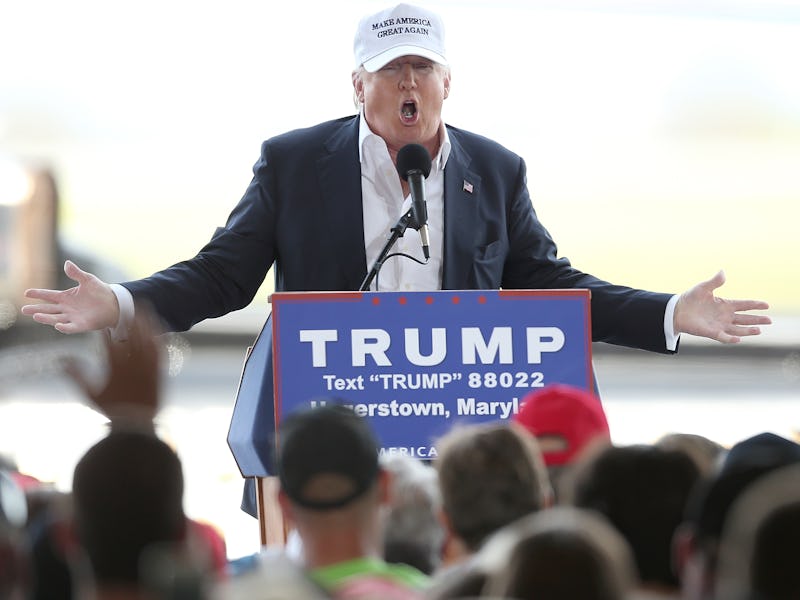How 3 of Donald Trump's Twitter Rants Changed the Polls Against Cruz and Kasich
And will his latest help him in tonight's primaries?

On Monday, Donald Trump took to his preferred platform — Twitter — to blast his rivals “Lyin’ Ted” Cruz and “One for 38” John Kasich.
His two main rivals announced on Sunday night a plan to combine forces in an attempt to stop Trump from winning the Republican nomination for president. Essentially, they pulled the political equivalent of agreeing to gang up on the person who managed to take all of Asia and Europe in a game of Risk — although the anti-Trump alliance appears to be falling apart already.
Trump, who’s touchy about everything from people being unfair to him to jokes about his tiny hands, loves to pop off on Twitter at the slightest provocation, and it turns out it it works — sometimes.
He tends to go on the Twitter offensive when he’s faced with a setback: he’s lost a primary or been insulted. His strategy appears to be “if he’s talking, he’s winning,” but polling data from RealClearPolitics shows that like the rest of us, Trump doesn’t really have any idea of what he’s doing on Twitter.
It’s worth noting that amalgamating political polls that came out roughly after Trump’s Tweet-storms is an inaccurate science, but bear with us as we descend into the depths of the 140-character medium of the modern age.
We’ll start in early February: After a losing the Iowa caucus to Ted Cruz, Trump hit the tweet button hard. First he blamed the media:
Then he blamed Cruz for “stealing” the state. Or maybe he blamed the voters? We’re not sure, but when the Donald doesn’t like what he sees in the polls, he lets us know about it:
Part of this might have been shock: before the Iowa caucus, he had hit soaring numbers in a CNN poll, putting up a spread of +22 percentage points over Cruz, but then dropped sharply leading up to the primary. He lost Iowa by more than 3 percentage points, and blasted out the tweets. They were immediately followed by the biggest drop in his numbers in the campaign (look at the top of this graph).
That big drop in February is right after the Iowa loss.
But a week after the tweet-storm, it was all Trump again, as he clawed his way back to the top 140 characters at a time. Check the polls below.
From left: name of the poll; date; number of “Likely Voters” or “Registered Voters;” percentage for Trump, Cruz, and Kasich; and spread between the leader and second place. It’s all Trump:
Check the right column -- the dip in the middle is right around tantrum-time.
But this is in the middle of Trump’s reign of terror. What happened earlier in the campaign, when Trump had started to taste victory but hadn’t reached his peak?
In late September, Trump was struggling again — some polls had him ahead, but his numbers weren’t particularly strong. Here’s a snapshot of the RealClearPolitics data from that time period.
This one didn't work out so well.
Trump decided to double down on his feud with Fox News, adding Bill O’Reilly (and pretty much everyone except for Sean Hannity) to his shit-list alongside Megyn Kelly.
Rich Lowry got it too.
Fox, Trump claimed, had not been reporting the right polls.
If we look at the numbers again, this time, Trump’s Twitter-flailing doesn’t really help him. He wasn’t the clear frontrunner at this time, fluctuating in the polls with Carson, Bush, and Rubio, all of whom have now dropped out. He gets a little bump in USA Today/Suffolk and Pew Research polls right after the rant, but that’s about it.
So what happened on Monday?
Again, Trump’s under some pressure — his lead is slowly shrinking, and even though the Cruz-Kasich alliance probably won’t last, he’s hoping that harsh words will give him more attention (spoilers: it’s working):
Then the name-calling started.
To be fair, Trump does have a flair for derogatory nicknames:
Tuesday’s primary results in Connecticut, Delaware, Maryland, Pennsylvania, and Rhode Island will be telling. Trump still has a commanding lead in the last polls, which were probably held before his latest Twitter rant, so the five Republican primary contests on Tuesday night could be the best litmus test as to whether this last outburst worked.